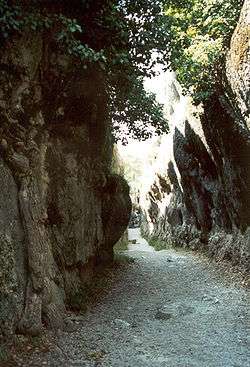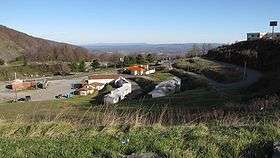Wind gap
A wind gap (or air gap)[1] is a gap through which a waterway once flowed that is now dry as a result of stream capture.[2] A water gap is a similar feature, but one in which a waterway still flows. Water gaps and wind gaps often provide routes which, due to their gently inclined profile, are suitable for trails, roads, and railroads through mountainous terrain.


Examples of wind gaps in the Blue Ridge Mountains of Virginia include Swift Run Gap, Rockfish Gap, and Buford's Gap. The last was the original crossing of the Blue Ridge Mountains near Bedford for the Virginia and Tennessee Railroad, later the Norfolk and Western Railway, a precursor of today's Norfolk Southern Railway system. Another wind gap with substantial importance in U.S. history is the Cumberland Gap near the junction of Kentucky, Virginia, and Tennessee.
References
- Neuendorf, Klaus K. E.; Institute, American Geological (2005). Glossary of Geology. Springer Science & Business Media. ISBN 9780922152766.
- Digital Atlas of Idaho - Glossary of Natural History Terms
| Wikimedia Commons has media related to Wind gap images. |